JWI 530: Financial Management I - Case Study Analysis Assignment
VerifiedAdded on 2023/04/23
|6
|1185
|388
Case Study
AI Summary
This assignment analyzes three financial management case studies, focusing on capital budgeting and investment decisions. The analysis includes calculating payback periods, internal rates of return, and net present values to evaluate investment proposals. The document addresses questions related to each case, considering factors like economic conditions, technological changes, and government regulations. The scenarios explore different investment options, their risks, and the factors influencing the final investment decisions, providing a comprehensive understanding of financial analysis and its application in real-world business scenarios. The assignment also delves into non-financial aspects that impact company performance, offering a holistic view of financial management.

Running head: ACCOUNTING 0
Accounting
Accounting
Paraphrase This Document
Need a fresh take? Get an instant paraphrase of this document with our AI Paraphraser
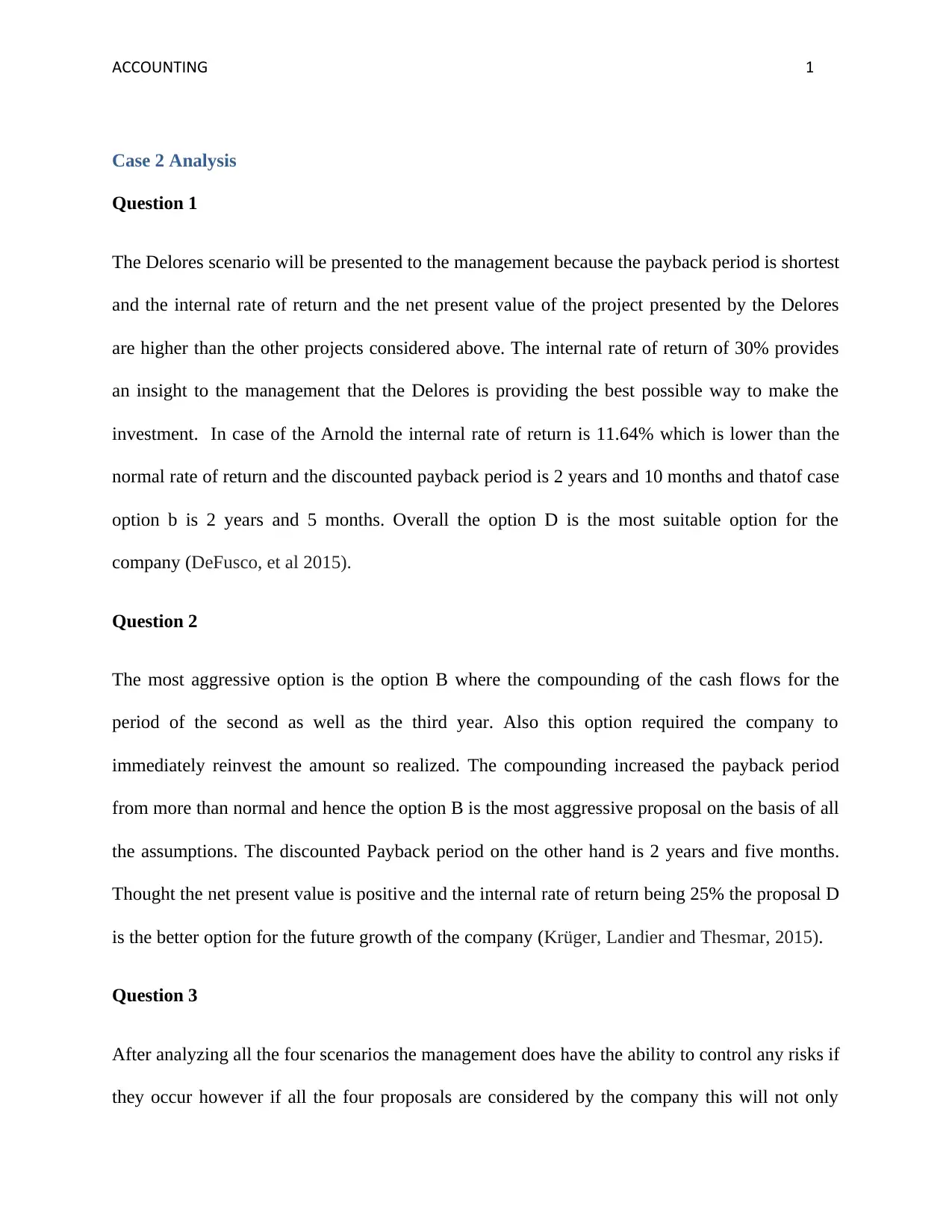
ACCOUNTING 1
Case 2 Analysis
Question 1
The Delores scenario will be presented to the management because the payback period is shortest
and the internal rate of return and the net present value of the project presented by the Delores
are higher than the other projects considered above. The internal rate of return of 30% provides
an insight to the management that the Delores is providing the best possible way to make the
investment. In case of the Arnold the internal rate of return is 11.64% which is lower than the
normal rate of return and the discounted payback period is 2 years and 10 months and thatof case
option b is 2 years and 5 months. Overall the option D is the most suitable option for the
company (DeFusco, et al 2015).
Question 2
The most aggressive option is the option B where the compounding of the cash flows for the
period of the second as well as the third year. Also this option required the company to
immediately reinvest the amount so realized. The compounding increased the payback period
from more than normal and hence the option B is the most aggressive proposal on the basis of all
the assumptions. The discounted Payback period on the other hand is 2 years and five months.
Thought the net present value is positive and the internal rate of return being 25% the proposal D
is the better option for the future growth of the company (Krüger, Landier and Thesmar, 2015).
Question 3
After analyzing all the four scenarios the management does have the ability to control any risks if
they occur however if all the four proposals are considered by the company this will not only
Case 2 Analysis
Question 1
The Delores scenario will be presented to the management because the payback period is shortest
and the internal rate of return and the net present value of the project presented by the Delores
are higher than the other projects considered above. The internal rate of return of 30% provides
an insight to the management that the Delores is providing the best possible way to make the
investment. In case of the Arnold the internal rate of return is 11.64% which is lower than the
normal rate of return and the discounted payback period is 2 years and 10 months and thatof case
option b is 2 years and 5 months. Overall the option D is the most suitable option for the
company (DeFusco, et al 2015).
Question 2
The most aggressive option is the option B where the compounding of the cash flows for the
period of the second as well as the third year. Also this option required the company to
immediately reinvest the amount so realized. The compounding increased the payback period
from more than normal and hence the option B is the most aggressive proposal on the basis of all
the assumptions. The discounted Payback period on the other hand is 2 years and five months.
Thought the net present value is positive and the internal rate of return being 25% the proposal D
is the better option for the future growth of the company (Krüger, Landier and Thesmar, 2015).
Question 3
After analyzing all the four scenarios the management does have the ability to control any risks if
they occur however if all the four proposals are considered by the company this will not only
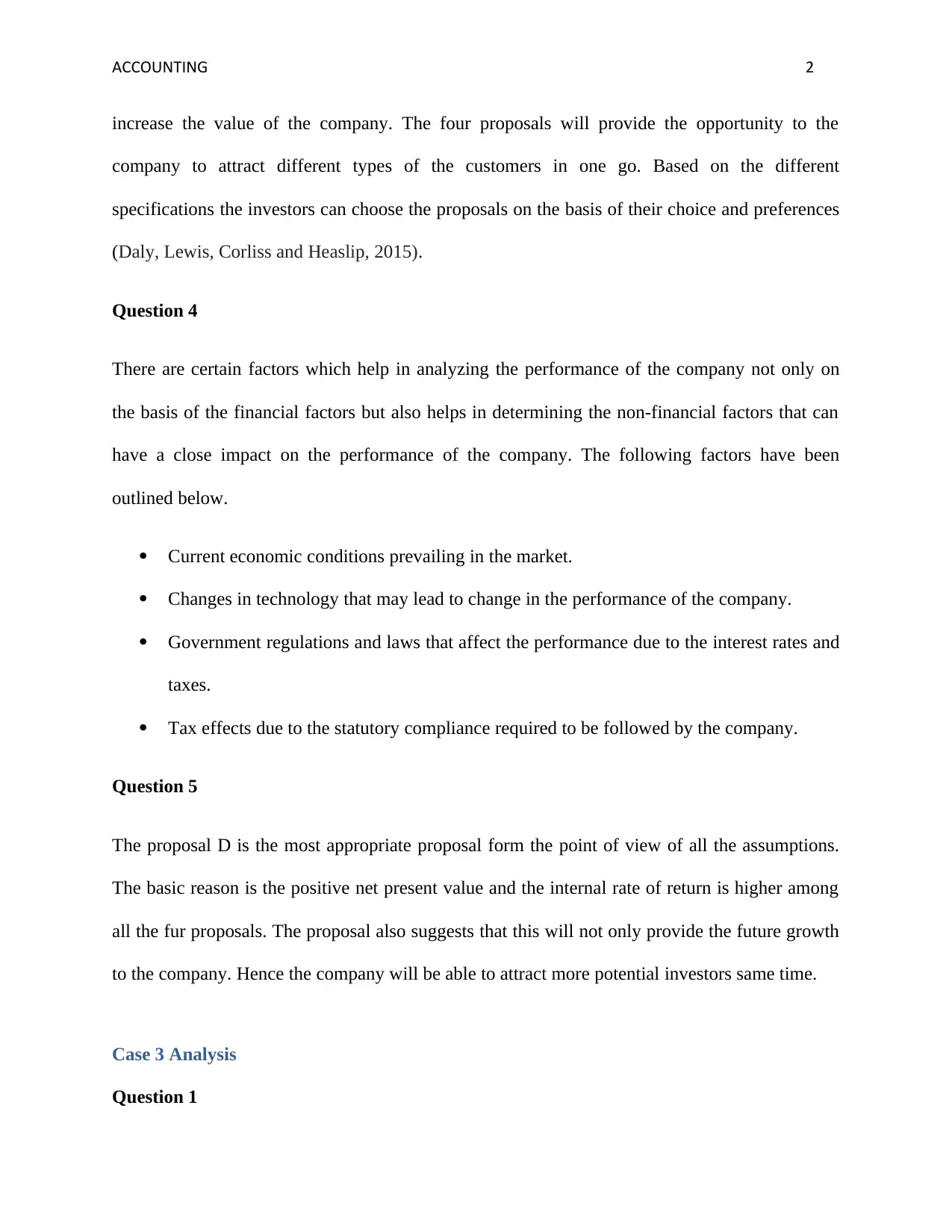
ACCOUNTING 2
increase the value of the company. The four proposals will provide the opportunity to the
company to attract different types of the customers in one go. Based on the different
specifications the investors can choose the proposals on the basis of their choice and preferences
(Daly, Lewis, Corliss and Heaslip, 2015).
Question 4
There are certain factors which help in analyzing the performance of the company not only on
the basis of the financial factors but also helps in determining the non-financial factors that can
have a close impact on the performance of the company. The following factors have been
outlined below.
Current economic conditions prevailing in the market.
Changes in technology that may lead to change in the performance of the company.
Government regulations and laws that affect the performance due to the interest rates and
taxes.
Tax effects due to the statutory compliance required to be followed by the company.
Question 5
The proposal D is the most appropriate proposal form the point of view of all the assumptions.
The basic reason is the positive net present value and the internal rate of return is higher among
all the fur proposals. The proposal also suggests that this will not only provide the future growth
to the company. Hence the company will be able to attract more potential investors same time.
Case 3 Analysis
Question 1
increase the value of the company. The four proposals will provide the opportunity to the
company to attract different types of the customers in one go. Based on the different
specifications the investors can choose the proposals on the basis of their choice and preferences
(Daly, Lewis, Corliss and Heaslip, 2015).
Question 4
There are certain factors which help in analyzing the performance of the company not only on
the basis of the financial factors but also helps in determining the non-financial factors that can
have a close impact on the performance of the company. The following factors have been
outlined below.
Current economic conditions prevailing in the market.
Changes in technology that may lead to change in the performance of the company.
Government regulations and laws that affect the performance due to the interest rates and
taxes.
Tax effects due to the statutory compliance required to be followed by the company.
Question 5
The proposal D is the most appropriate proposal form the point of view of all the assumptions.
The basic reason is the positive net present value and the internal rate of return is higher among
all the fur proposals. The proposal also suggests that this will not only provide the future growth
to the company. Hence the company will be able to attract more potential investors same time.
Case 3 Analysis
Question 1
⊘ This is a preview!⊘
Do you want full access?
Subscribe today to unlock all pages.

Trusted by 1+ million students worldwide
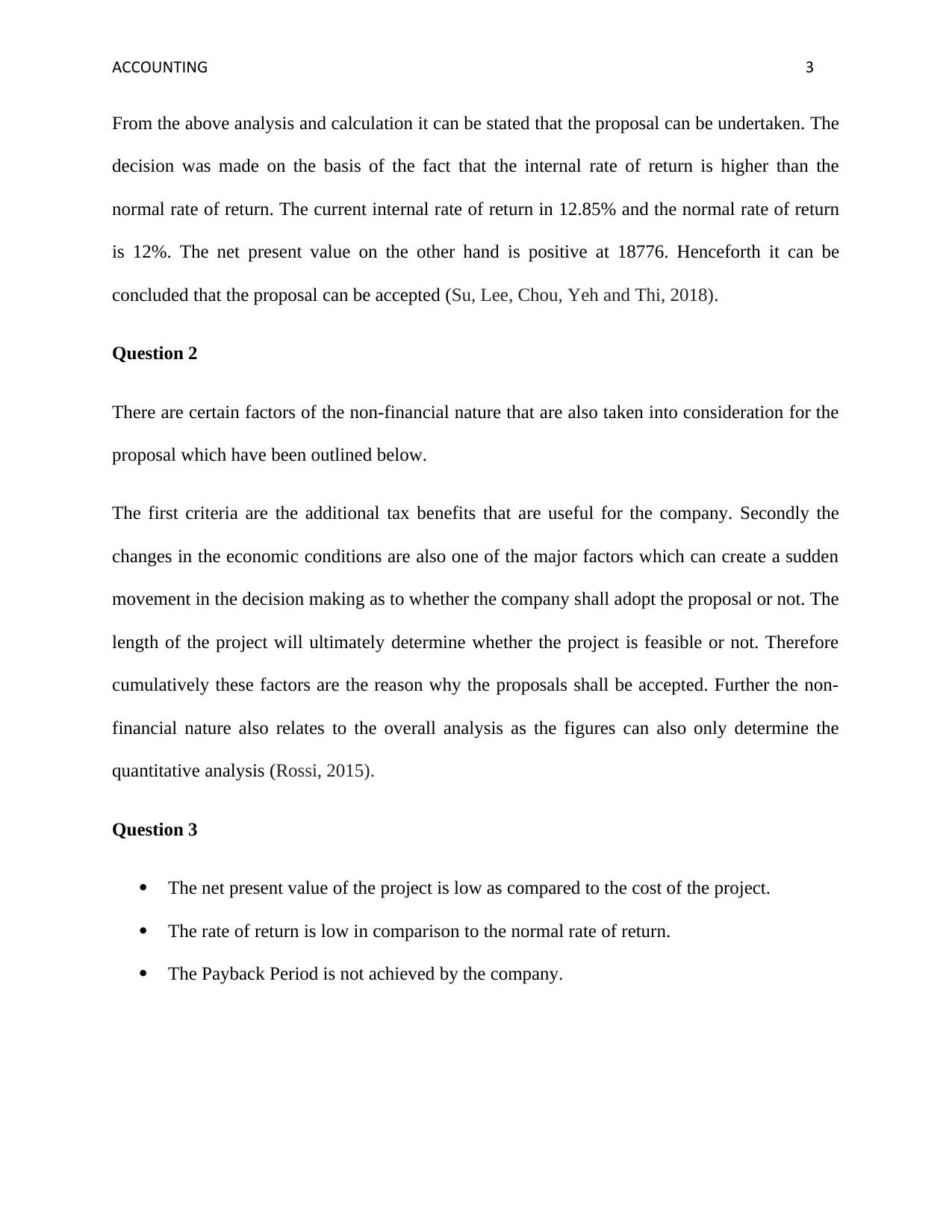
ACCOUNTING 3
From the above analysis and calculation it can be stated that the proposal can be undertaken. The
decision was made on the basis of the fact that the internal rate of return is higher than the
normal rate of return. The current internal rate of return in 12.85% and the normal rate of return
is 12%. The net present value on the other hand is positive at 18776. Henceforth it can be
concluded that the proposal can be accepted (Su, Lee, Chou, Yeh and Thi, 2018).
Question 2
There are certain factors of the non-financial nature that are also taken into consideration for the
proposal which have been outlined below.
The first criteria are the additional tax benefits that are useful for the company. Secondly the
changes in the economic conditions are also one of the major factors which can create a sudden
movement in the decision making as to whether the company shall adopt the proposal or not. The
length of the project will ultimately determine whether the project is feasible or not. Therefore
cumulatively these factors are the reason why the proposals shall be accepted. Further the non-
financial nature also relates to the overall analysis as the figures can also only determine the
quantitative analysis (Rossi, 2015).
Question 3
The net present value of the project is low as compared to the cost of the project.
The rate of return is low in comparison to the normal rate of return.
The Payback Period is not achieved by the company.
From the above analysis and calculation it can be stated that the proposal can be undertaken. The
decision was made on the basis of the fact that the internal rate of return is higher than the
normal rate of return. The current internal rate of return in 12.85% and the normal rate of return
is 12%. The net present value on the other hand is positive at 18776. Henceforth it can be
concluded that the proposal can be accepted (Su, Lee, Chou, Yeh and Thi, 2018).
Question 2
There are certain factors of the non-financial nature that are also taken into consideration for the
proposal which have been outlined below.
The first criteria are the additional tax benefits that are useful for the company. Secondly the
changes in the economic conditions are also one of the major factors which can create a sudden
movement in the decision making as to whether the company shall adopt the proposal or not. The
length of the project will ultimately determine whether the project is feasible or not. Therefore
cumulatively these factors are the reason why the proposals shall be accepted. Further the non-
financial nature also relates to the overall analysis as the figures can also only determine the
quantitative analysis (Rossi, 2015).
Question 3
The net present value of the project is low as compared to the cost of the project.
The rate of return is low in comparison to the normal rate of return.
The Payback Period is not achieved by the company.
Paraphrase This Document
Need a fresh take? Get an instant paraphrase of this document with our AI Paraphraser
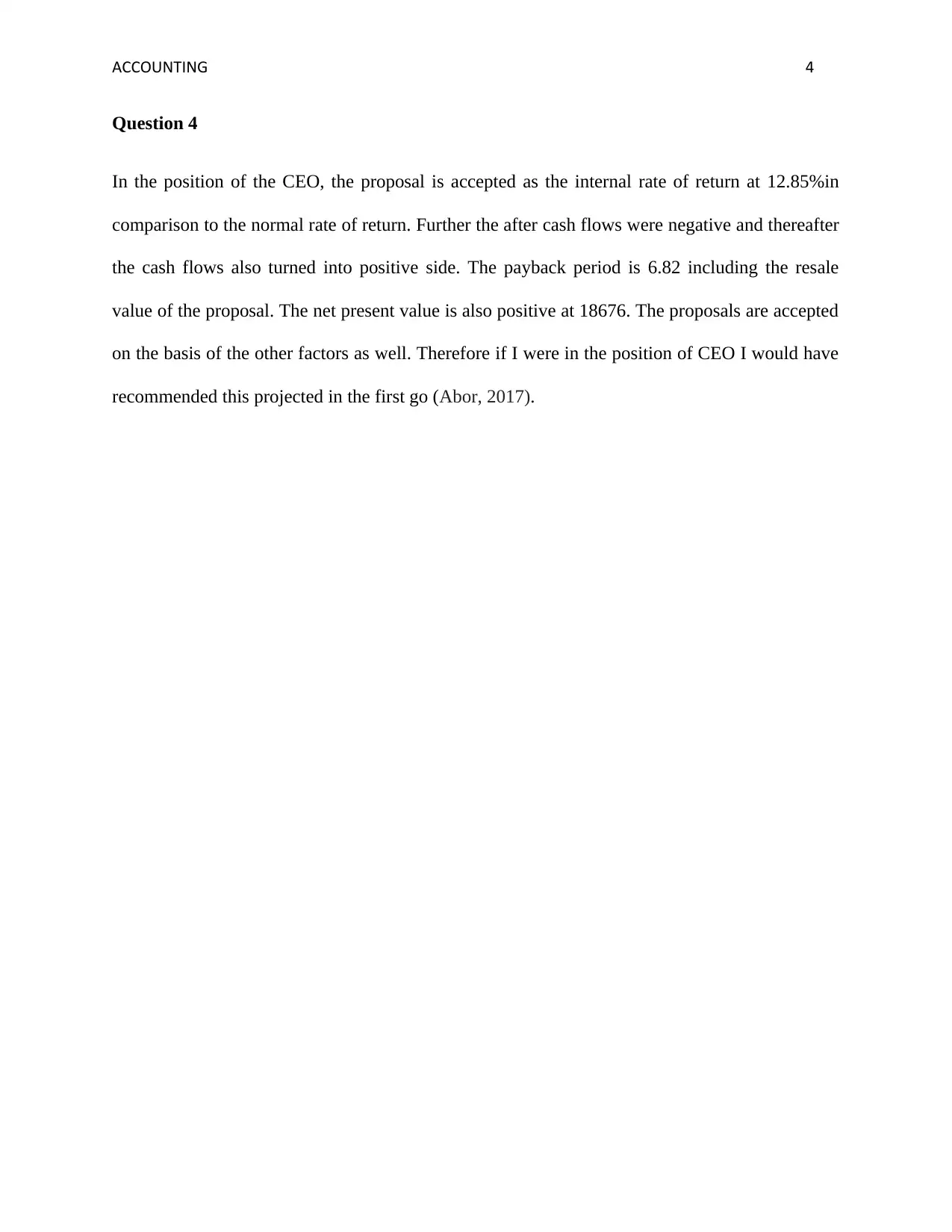
ACCOUNTING 4
Question 4
In the position of the CEO, the proposal is accepted as the internal rate of return at 12.85%in
comparison to the normal rate of return. Further the after cash flows were negative and thereafter
the cash flows also turned into positive side. The payback period is 6.82 including the resale
value of the proposal. The net present value is also positive at 18676. The proposals are accepted
on the basis of the other factors as well. Therefore if I were in the position of CEO I would have
recommended this projected in the first go (Abor, 2017).
Question 4
In the position of the CEO, the proposal is accepted as the internal rate of return at 12.85%in
comparison to the normal rate of return. Further the after cash flows were negative and thereafter
the cash flows also turned into positive side. The payback period is 6.82 including the resale
value of the proposal. The net present value is also positive at 18676. The proposals are accepted
on the basis of the other factors as well. Therefore if I were in the position of CEO I would have
recommended this projected in the first go (Abor, 2017).
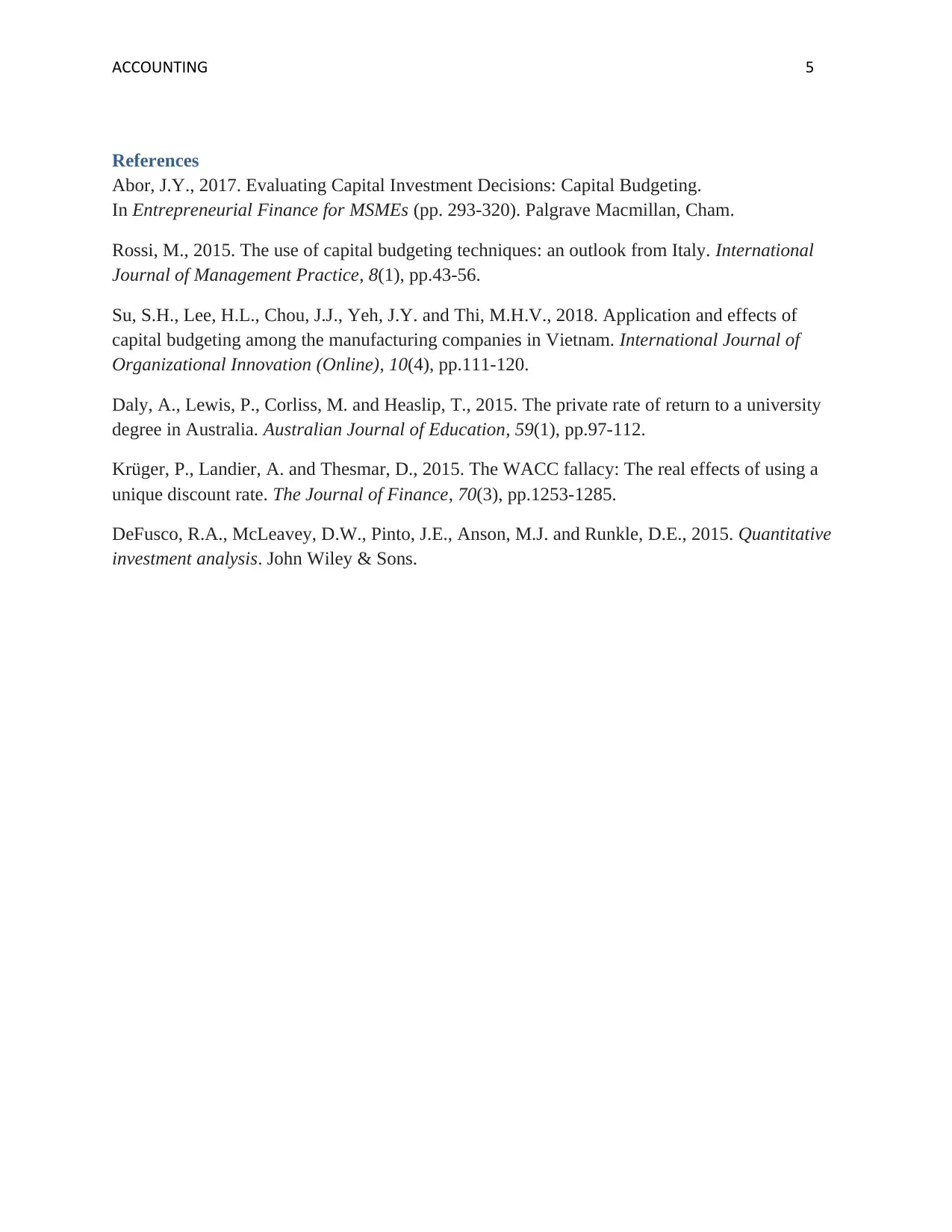
ACCOUNTING 5
References
Abor, J.Y., 2017. Evaluating Capital Investment Decisions: Capital Budgeting.
In Entrepreneurial Finance for MSMEs (pp. 293-320). Palgrave Macmillan, Cham.
Rossi, M., 2015. The use of capital budgeting techniques: an outlook from Italy. International
Journal of Management Practice, 8(1), pp.43-56.
Su, S.H., Lee, H.L., Chou, J.J., Yeh, J.Y. and Thi, M.H.V., 2018. Application and effects of
capital budgeting among the manufacturing companies in Vietnam. International Journal of
Organizational Innovation (Online), 10(4), pp.111-120.
Daly, A., Lewis, P., Corliss, M. and Heaslip, T., 2015. The private rate of return to a university
degree in Australia. Australian Journal of Education, 59(1), pp.97-112.
Krüger, P., Landier, A. and Thesmar, D., 2015. The WACC fallacy: The real effects of using a
unique discount rate. The Journal of Finance, 70(3), pp.1253-1285.
DeFusco, R.A., McLeavey, D.W., Pinto, J.E., Anson, M.J. and Runkle, D.E., 2015. Quantitative
investment analysis. John Wiley & Sons.
References
Abor, J.Y., 2017. Evaluating Capital Investment Decisions: Capital Budgeting.
In Entrepreneurial Finance for MSMEs (pp. 293-320). Palgrave Macmillan, Cham.
Rossi, M., 2015. The use of capital budgeting techniques: an outlook from Italy. International
Journal of Management Practice, 8(1), pp.43-56.
Su, S.H., Lee, H.L., Chou, J.J., Yeh, J.Y. and Thi, M.H.V., 2018. Application and effects of
capital budgeting among the manufacturing companies in Vietnam. International Journal of
Organizational Innovation (Online), 10(4), pp.111-120.
Daly, A., Lewis, P., Corliss, M. and Heaslip, T., 2015. The private rate of return to a university
degree in Australia. Australian Journal of Education, 59(1), pp.97-112.
Krüger, P., Landier, A. and Thesmar, D., 2015. The WACC fallacy: The real effects of using a
unique discount rate. The Journal of Finance, 70(3), pp.1253-1285.
DeFusco, R.A., McLeavey, D.W., Pinto, J.E., Anson, M.J. and Runkle, D.E., 2015. Quantitative
investment analysis. John Wiley & Sons.
⊘ This is a preview!⊘
Do you want full access?
Subscribe today to unlock all pages.

Trusted by 1+ million students worldwide
1 out of 6